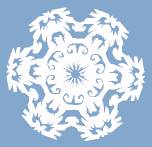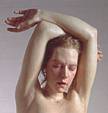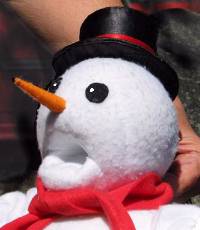 Amazon UK has a couple of copies of the book ‘Ron Mueck: Boy’ by the photographer Gautier Deblonde. This is a photographic diary of the nine months it took to construct, ship and assemble the sculpture in Venice. It was the ‘Art in Photo Essays’ award recipient in the World Press Photo of the Year, 2001, but seems to be out of print at present. I was interested to see the sculpture in segments, and crated.
Amazon UK has a couple of copies of the book ‘Ron Mueck: Boy’ by the photographer Gautier Deblonde. This is a photographic diary of the nine months it took to construct, ship and assemble the sculpture in Venice. It was the ‘Art in Photo Essays’ award recipient in the World Press Photo of the Year, 2001, but seems to be out of print at present. I was interested to see the sculpture in segments, and crated.
make
Snowflakes and Paper Cutting
 Make-a-Flake is a cool flash application that enables you to make snowflake patterns like the ones we cut out of paper when we were kids. They have a gallery of the beautiful patterns that visitors to the site have made, and you can add your own.
Make-a-Flake is a cool flash application that enables you to make snowflake patterns like the ones we cut out of paper when we were kids. They have a gallery of the beautiful patterns that visitors to the site have made, and you can add your own.
Playing with the snowflake maker reminded me of the work of Béatrice Coron. I particularly like her vast but finely-detailed city scapes, such as Innercity; ExCentriCity; and Chicago. Also, SagaCity, the cutting edge is a photographic account of Cororn’s installation at the Chicago Center for Book & Paper Arts in 2003.
Its interesting to see the other directions in which Coron’s book art goes. For instance, she has recently make a 9 foot high stainless steel cut out sculpture called ‘Working in the Same Direction’ to represent the first merger of the Fire Department and Emergency Medical Services in New York City, in which the design of two panels is like an open book preserving ‘the independence of the two separate entities sharing a common goal’. I also like the idea of the two weathervanes — a fireman and an emergency medical worker that ‘move with the wind, watching in all directions’.
Here are a few other papercutting links that I have been interested in:
Diana Bryan’s Shadowtown
Gerlof Smit,in particular his Delicate cuttings.
ChinaVista
Sun Erlin: A Cut Above
A Chinese Zodiac
Anita Sinclair’s book ‘The Puppetry Handbook’
 Anita Sinclair’s book The Puppetry Handbook is a really useful comprehensive resource for anyone involved with making puppets. It has detailed coverage (including many drawings) of the main techniques, processes and materials that are used for building all kinds of puppets, and also gives consideration as to which sort of puppet to build for different circumstances. It also has good advice on all kinds of puppetry performances and teaching puppet making. A friend of mine was showing me a new edition that she had recently ordered. Its now spiral bound and slightly larger (about an A4 size) than my old copy, both good changes I think.
Anita Sinclair’s book The Puppetry Handbook is a really useful comprehensive resource for anyone involved with making puppets. It has detailed coverage (including many drawings) of the main techniques, processes and materials that are used for building all kinds of puppets, and also gives consideration as to which sort of puppet to build for different circumstances. It also has good advice on all kinds of puppetry performances and teaching puppet making. A friend of mine was showing me a new edition that she had recently ordered. Its now spiral bound and slightly larger (about an A4 size) than my old copy, both good changes I think.
Paulus Berensohn: Deep Ecologist and Crafts Artist
I’ve been sculpting with clay the last few days, a favourite activity. I love the feel of it, and how malleable yet solid it is. These days it always makes me think about an interview with Paulus Berensohn that I heard a while ago on the ABC’s Earthbeat program. Berensohn is a Deep Ecologist and craft artist, and he is best known for his book Finding One’s Way With Clay. I was taken with some of the things he says in the interview. Here are a few examples:
“But I started in my late teens as a dancer, and was a dancer until I was 30 and then one night in the middle of a performance, at a climax in the dance where we then had to freeze, a voice in my head said, ‘This is dancing on a stage, what does it mean to dance in life?’ And very shortly after that, I was taken to a picnic, and there was a great American potter there, and I watched her throwing on the wheel, and I made that connection that the act of throwing clay on a potter’s wheel was a kind of dancing. And I was just enchanted, and wanted to learn that dance”…
“I mean I personally think that the craft arts isn’t about an alternative way of making a living and filling museums and galleries with gorgeous objects, I think it’s the clay and the fibre and the metals and the wood saying ‘Listen, listen to me. Put your hands on me, and you’ll make contact with a living world.’ “…
“The word ‘art’, if you go back into its etymological roots, it’s not a noun, it’s a verb, it’s a doing, an acting, and it comes from the root for ‘to join’. So one is behaving artistically, one is in a state of intimacy and communion with the activity at hand”…
“We have in our DNA the memory of having fur and a memory of having whiskers that connected us to nature”…
“The first time I ever encountered an Aboriginal Australian, was in New Mexico, and they had invited an Aboriginal elder to come to speak to the native Americans and he was, I wish I remembered his name, he was wonderful. And he came with slides of stones and sunsets and sunrises. He would show a sunrise, and he would say, ‘This is a sunrise in Australia; you must watch the sunrise every day, it is a blessing for Mother Earth’, and then he would show a sunset, and he would say, ‘You must watch the sun set.’ “…
“So one of the things in journals you can do is keep lists, and one of the lists I keep is Who else is here? Who else is participating in this life? So like in these months that I’ve been on Tasmania, yes, here’s one I wrote: 2 Huntsman spiders, one on the lid of the compost toilet. The other was inside a straw hat of Peter’s which he wore for five minutes before he felt something crawling on his head. Luckily he took of his hat before it bit him. It was at least four inches across. Four possums by the side of the road as we drove home late from Hobart last night. Red tide in Nubena threatening the salmon farming pens. Gustav says they are dinoflagellates and that what Peter and I saw my first night here as a phosphorescent tide is the same as the red tide. See, I never knew that”…
“It’s the artist’s work to sing up the earth, to praise and thank and to express gratitude. Well that’s what I think art is. That’s why I think art is a behaviour, to sing up the earth.”
Ron Mueck again : Big Man
I’ve come across two new links for Ron Mueck since my previous post about his work. There is a very unimpressed review by Adrian Searle in the Guardian in March 2003. Secondly there is ‘A Conversation with Ron Mueck’ by Sarah Tanguy, in the International Sculpture Center’s July/August 2003 magazine Sculpture. Mueck talks about the making of his Big Man sculpture in particular and in detail. There is a really interesting sequence of 6 photos which show the progress and techniques that were used.
Update: I noticed today (30 Oct 05) that the second link about the making of Big Man had been changed since I made the original post, so I have corrected it. I’ve been getting quite a lot of hits here, presumeably because Big Man is on show in Paris, so do take another look!
Ron Mueck’s Pregnant Woman sculpture
 One of the recent acquisitions at the National Gallery of Australia here in Canberra is a larger-than-life sculpture of a naked pregnant woman by Ron Mueck. Its an extraordinary thing: 2.5 metres tall, and so life-like in its attention to the minutest detail and colouring that you are compelled to get up close to look, and then suddenly feel as if you have got way too personal. Then again the woman seems entirely in her own world, feeling the enormity of pregnancy in every way, and as if nothing else can impinge on those sensations.
One of the recent acquisitions at the National Gallery of Australia here in Canberra is a larger-than-life sculpture of a naked pregnant woman by Ron Mueck. Its an extraordinary thing: 2.5 metres tall, and so life-like in its attention to the minutest detail and colouring that you are compelled to get up close to look, and then suddenly feel as if you have got way too personal. Then again the woman seems entirely in her own world, feeling the enormity of pregnancy in every way, and as if nothing else can impinge on those sensations.
The gallery is also showing a video of the making of Pregnant Woman, which was very interesting to me as a maker. The sculpture is made of fibre glass and silicon, and the video shows the elaborate processes of mold making and casting that was involved. I’m not sure if the video being offered for sale at the National Gallery, Trafalgar Square, London, is the same, but it looks from the description as if it might be. One technique that I thought might prove useful is that shellac can be painted on a clay sculpture to prevent it drying out.
Here are some links to some collections of Ron Mueck’s amazing work: again, the sculptures are all superbly realistic except for some twist involving scale:
Dead Dad from the BBC’s The Saatchi Phenomenon . The figure is less than life-size in death.
Artmolds.com. Numerous works.
ABC’s Gateway to Arts and Culture: 49th Venice Biennale: Ron Mueck’s ‘Boy’. This includes a RealVideo walkaround of ‘Boy’ shot by Pollyanna Sutton.
Boy. A couple of pictures.
James Cohen Galleries. Numerous works pictured, and a collection of articles and reviews in pdf files.
Milo the Clown’s Snow Show
 I’ve recently finished a small Frosty the Snowman puppet for The Fool Factory. Frosty will be joining Mini Milo and Milo the Clown in Milo the Clown’s Snow Show, playing at Thredbo’s Fun and Games Room from April 10th through 16th.
I’ve recently finished a small Frosty the Snowman puppet for The Fool Factory. Frosty will be joining Mini Milo and Milo the Clown in Milo the Clown’s Snow Show, playing at Thredbo’s Fun and Games Room from April 10th through 16th.
Van Gogh Hot Air Balloon
I love the hot air balloon festivals in Canberra, particularly the one on now, part of Canberra Week. Getting up and mooching around the balloons as they set up on the lawns at Old Parliament House at dawn is a lot easier in autumn than in the cold of winter when the other major balloon festival takes place. I remember when the ballooning festivals started here about 16 years ago. I was blown away by the magic of the things: their sheer size, how they looked like giant pregnant women lying on the grass; the dragon’s breath roar of the burners; and their silence in between times. I also love the special shaped balloons. Over the years the most memorable have been the birthday cake, the upside down balloon, the cow, the polar bear, the Swatch watch, the Freddo frog, and the kookaburra. Its wonderfully surreal to see these things just appear out of nowhere in the sky, or see them floating among the clouds or drifting across the lake.
On Saturday, I went to this year’s lauch of the balloon fiesta. I was especially interested in the Van Gogh balloon, which was appearing in the southern hemisphere for the first time. And it was magnificent! Its a three-dimensional balloon replica of Van Gogh’s painting, Self Portrait with Grey Felt Hat, and was made in 2003 for the 150th anniversary of Van Gogh’s birth. The face has the rather grim exacting expresssion and textured brushstroke look that it should.
Apparently the balloon was made by modelling a 3-D plaster cast of the head from a digital photo of the portrait. The original portrait is kept at the Van Gogh Museum in Amsterdam. Actually there are three self portraits in grey felt hats, two in dark felt hats, seven in straw hats and two in caps – obviously he was a man who liked hats! But I imagine it is this portrait that the balloon was modelled on. The brush strokes were copied onto the model on the areas of the head that were not in the painting, and then transferred onto more than 1000 pieces of balloon cloth. This was done with a computer-directed laser printer. Up close to the balloon you can see the cloth has a definite digital print appearance, but that is lost quickly as you step away.
The other special shape balloons this year are a frog (also from the Nederlands), a bunch of balloons, an Aussie Rules football, and the Liberty House (with two cats on its roof). The advertisment for tyres on the football flapped a little at one corner, gradually came loose all down one side, and then shimmered gracefully to the ground, even before the balloon took to the sky. Which was probably a good thing if it was going to fall off somewhere.
Many of the special shape balloons in the world, including the Van Gogh, are made by Cameron’s Balloons in Bristol, UK. According to the Wikipaedia entry, Don Cameron started making balloons in 1971 in his basement, and they now make about 500 a year. You can take a virtual tour around their factory here. Camerons also make airships! And they made the Breitling Orbiter balloon that made aviation history by flying round the world in 1999. There is a model kit of the orbiter, if you fancy such things.
One of the balloonists I chatted to was telling me that Kavanagh balloons are the only manufacturers of hot air balloons in Australia. She had a Kavanagh balloon (and immediately I noticed others), and was visting from Mildura where the The Nudie 16th World Hot Air Balloon Championship is going to be staged from the 26 June – 3 July 2004. With over 80 competitors from around the world already signed up, it sounds exciting.
Automata
Sometime last year I happened across the Flying Pig Gallery, a site which houses whimsical paper automata models for you to cut out and make. There are numerous models in kit form, such as this hopping kangaroo, while others like the Agreeable Sheep are free to download. There’s also a very cool section of animations that illustrate mechanisms that are used in automata. They assure us that no sheep were hurt in the making of the trebuchet animation :-).
Of course if you are interested in automata, and haven’t come across them already, you need to know about Cabaret Mechanical Theatre, a Museum of Automata (Mechanical Sculpture). In particular, follow the artists links to see some wonderful creations.


